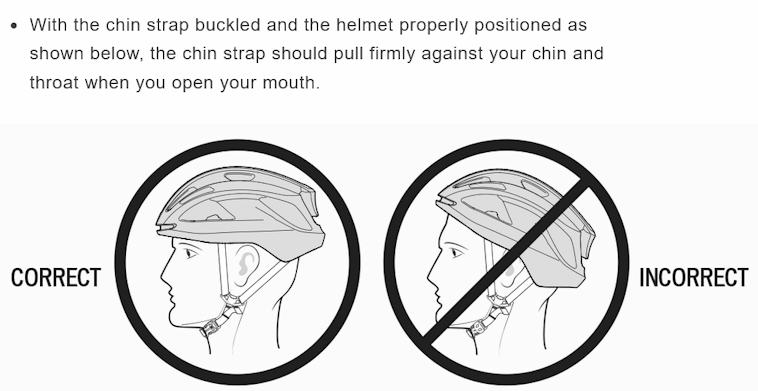By John Allen
45 years ago, proper bicycle helmets first went on sale. Not long after, CRW member Jacek Rudowski collided with a car, went over the hood, landed on his helmet in the street and survived without serious injury. That story spread through the club, and there were others. Soon, nearly everyone on CRW rides was wearing a helmet.
Helmet use remains contentious for people who want to make bicycling as convenient as possible. This is especially so in connection with urban bike-share systems, where a person stepping up to a bike-share kiosk probably isn’t carrying a helmet. There have even been claims that helmet promotion decreases safety, because safety in numbers will make motorists more attentive. You are supposed to decrease your own safety in pursuit of some benefit which may occur to society at large. It’s balderdash. The safety increase actually reflects increasing skill with more riding, and most bicycle crashes don’t involve a car at all.
A couple of the CRW helmet stories were my own. I had to replace a helmet in 1978, after being sideswiped by a drunk driver, and again in 1984, when a fallen tree branch got caught in my front wheel. In 2005, I crashed due to a pothole. It then should be no surprise that I care about good helmet selection, fit and adjustment. As a CRW member, you probably are already conscientious about this, but it deserves a refresher anyway.
The photo below is of my Bell Biker helmet after the 1984 tree branch incident. Note the scrape, and how the foam liner is compressed at the front. I needed a few stitches below my nose but walked out of the hospital emergency room three hours after the crash, carrying this helmet under my arm. It had been adjusted correctly and it protected me.

Having your helmet do its job is about more than just going through the motions of wearing one. So, this is my call to you (and friends) to check and adjust the helmet’s fit as needed. The helmet needs to be the right size; you need to adjust the strap so it divides just below the ears.
Properly adjusted, the helmet will sit level on your head. A snug strap was easy to achieve with my early Bell helmet. Its double-D-ring buckle would automatically adjust the strap every time I put the helmet on. I could add or remove a watch cap under the helmet in winter, without fiddling with the strap, and I could loosen the strap to rest the helmet on my back when I was off the bicycle. Bell abandoned this design early and no other manufacturer has taken it up. The likely reason is that the helmet couldn’t be unbuckled with the strap under tension. Children had helmets catch in playground equipment and as I recall, at least one died. All newer helmets I have seen or worn have had a “snap-shut” plastic buckle. The strap has an adjustment that slips and loosens, repeatedly needing attention to maintain good fit.
How tight should that strap be? A test demonstrated at a League of American Bicyclists conference in 2005 sets the standard: You need to feel the strap under your chin, to the extent that it feels uncomfortable when you open your mouth wide. Also, you can test by placing the palm of your hand on the front of the helmet and pushing back. The helmet should stay in place.
Recall that the helmet may need to stay put for more than one impact in a crash. Many newer helmets have a dial in the back to adjust fit. This is a nice feature, but it is a stabilizer, not part of the retention system. It will pop open in a crash. I can sort of get away with adding or removing a cap underneath while adjusting only the dial. There is a warm Gore-Tex cap that is very thin and serves the purpose well.
Oddly, the conventional information on strap adjustment has slackened (figuratively and literally) since the conference in 2005. Multiple sources now including the League of American Bicyclists are advising people to leave enough room under the strap to slide two or three fingers between it and the chin. I don’t understand where this trend got started, and I don’t agree with it. Again, you should not be able to push the helmet back and uncover your forehead. Check and adjust your helmet so it can work for you if you need it!
The text and illustrations from a page in the Specialized support center give good classic advice on strap adjustment. You want to avoid injury and Specialized wants to avoid lawsuits!

The nonprofit Bicycle Helmet Safety Institute, https://helmets.org, is the go-to Web site for information on bicycle helmets. The Web site holds standards, laws, performance tests, statistics, reviews of new models, and more.
All helmets sold for use on bicycles in the USA must meet Federal Consumer Product Safety Commission standards, but test results and reviews at BHSI show some helmets to be more protective than others, heavier or lighter, more ventilated, or less available to fit different head sizes and shapes. Some helmets are more suitable for bicycling, others for skateboarding. An expensive helmet does not necessarily work better. The Bicycle Helmet Safety Institute states that the MIPS feature, designed to reduce rotational shock to the brain, “may or may not help you avoid brain injury in a crash.” Testing of old helmets shows that performance actually deteriorates very slowly with time, regardless of what manufacturers would like to tell you. A wealth of information!
And BHSI says to snug up that strap!